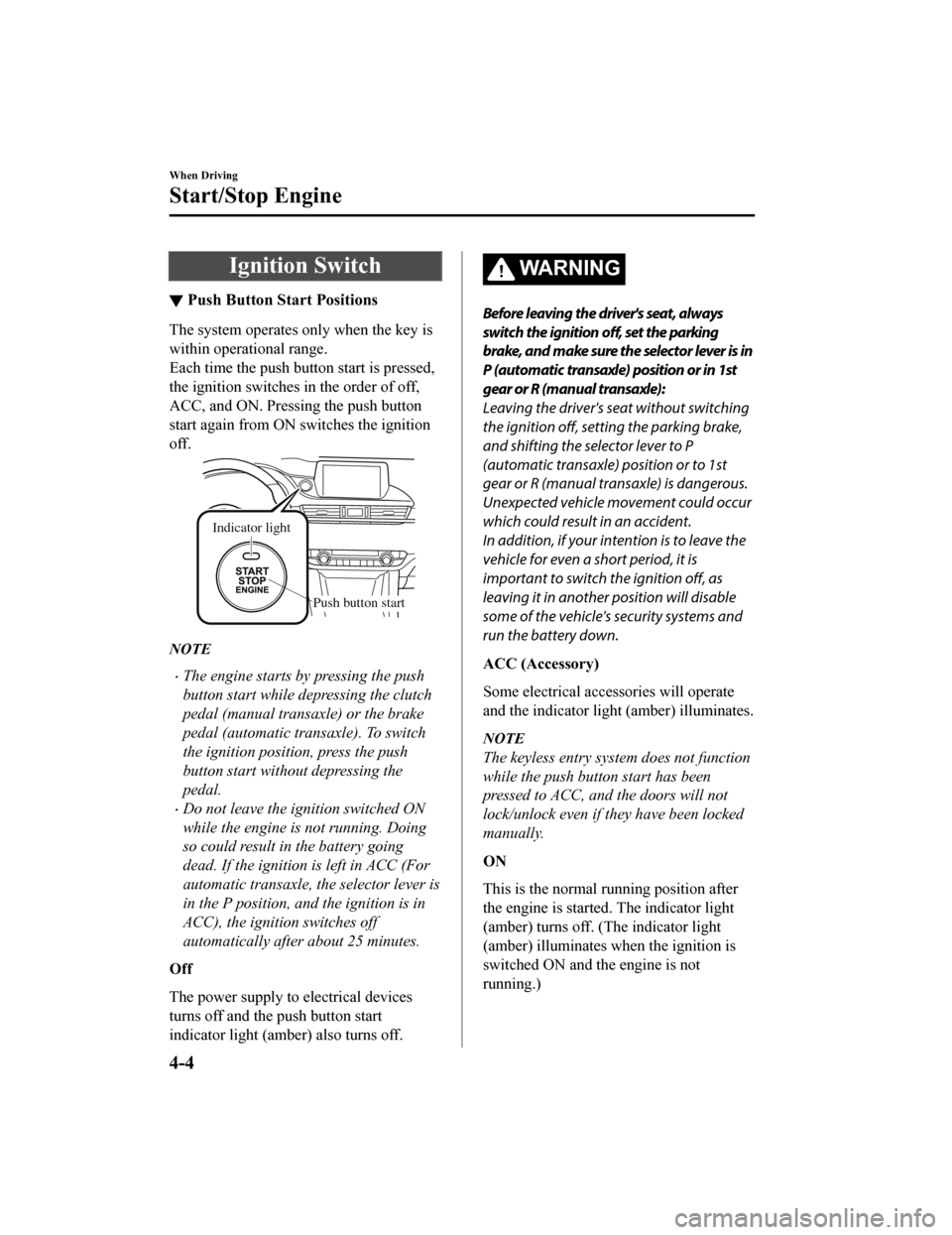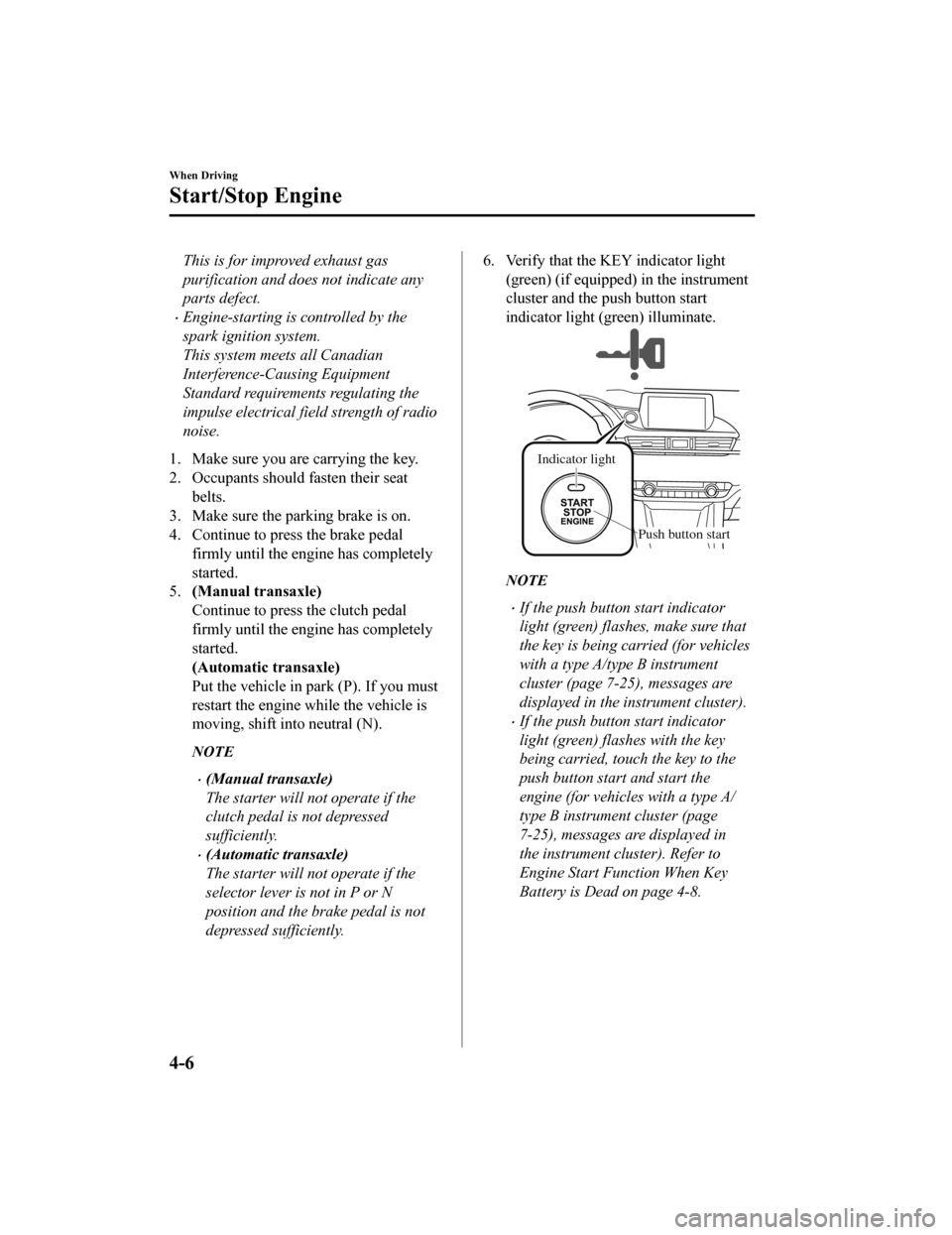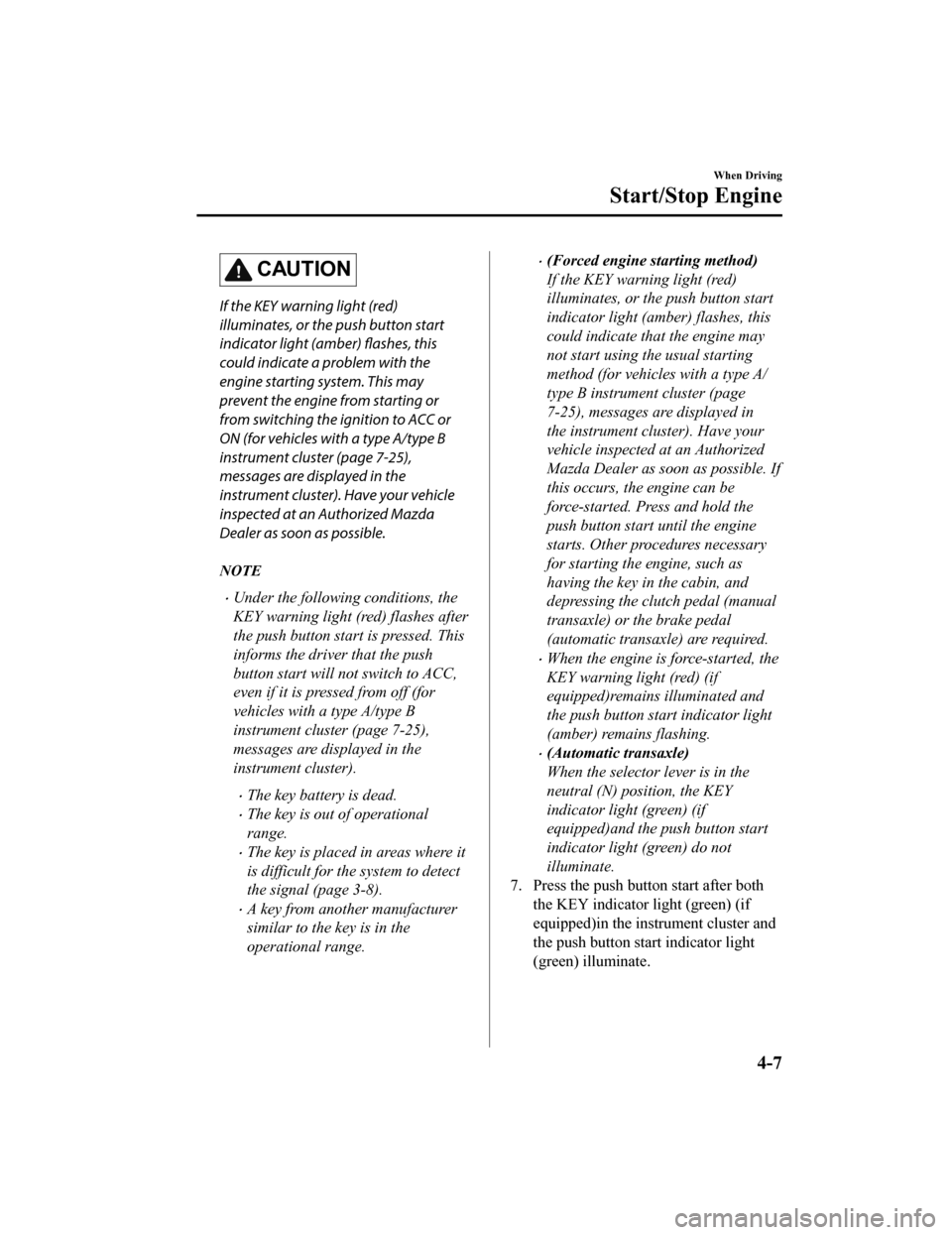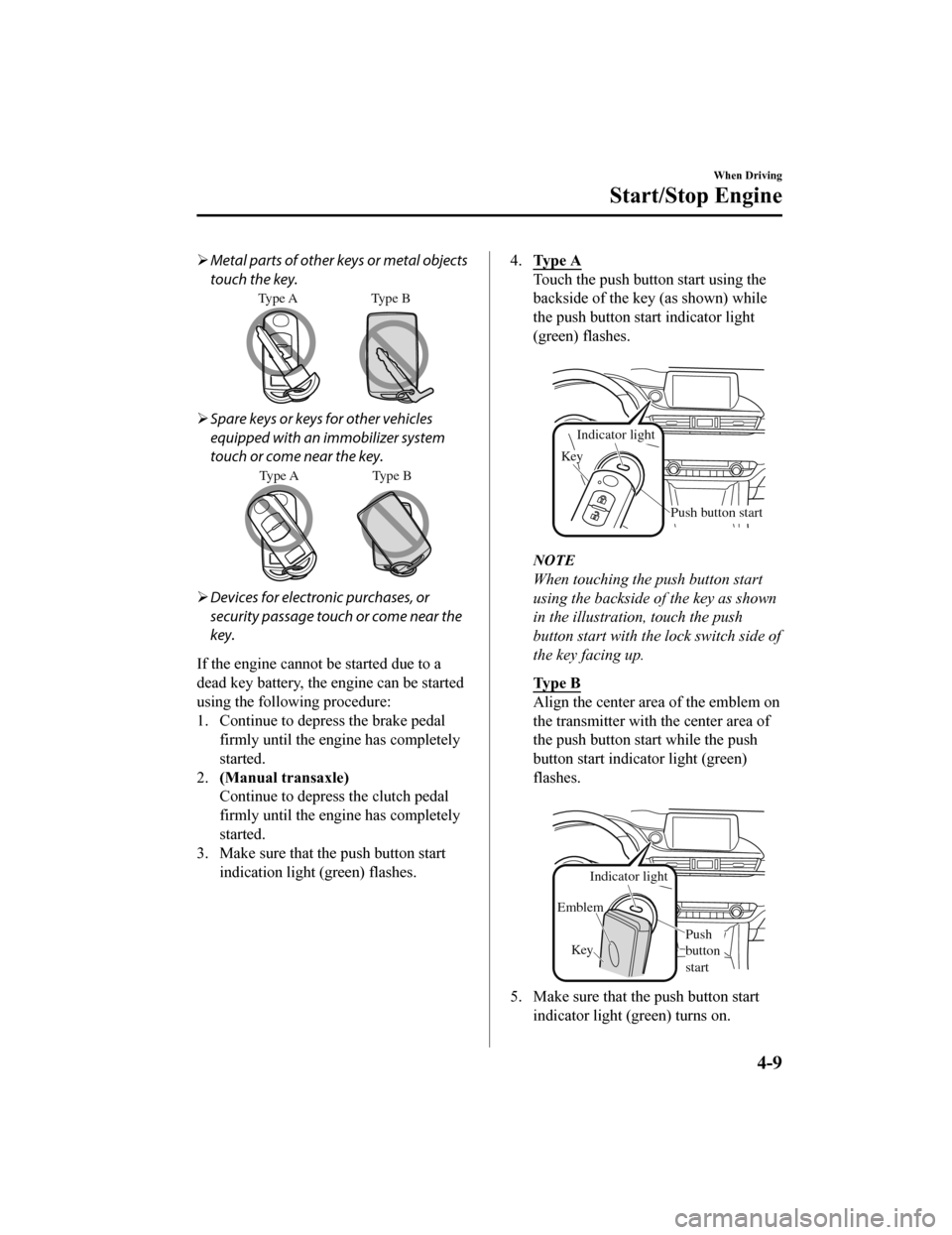light MAZDA MODEL 6 2020 (in English) Workshop Manual
[x] Cancel search | Manufacturer: MAZDA, Model Year: 2020, Model line: MODEL 6, Model: MAZDA MODEL 6 2020Pages: 702
Page 133 of 702

’éĘDrive slowly. Braking performance can
be adversely affected if snow or ice
adheres to the brake components. If this
situation occurs, drive the vehicle
slowly, releasing the accelerator pedal
and lightly applying the brakes several
times until the brake performance
returns to normal.
Ō¢╝Snow Tires
Use snow tires on all 4 wheels
Do not go faster than 120 km/h (75 mph)
while driving with sno
w tires. Inflate snow
tires 30 kPa (0.3 kgf/cm
2, 4.3 psi) more
than recommended on the tire pressure
label (driver's door frame), but never more
than the maximum c old-tire pressure
shown on the tires.
Mexico
The vehicle is originally equipped with
summer tires designed for optimum
traction on wet and dry roads. If your
vehicle is to be used on snow and ice
covered roads, Mazda recommends that
you replace the tires originally equipped
on your vehicle with snow tires during the
winter months.
Except Mexico
The vehicle is originally equipped with all
season radials designed to be used all year
around. In some extreme climates you
may find it necessary t o replace them with
snow tires during the winter months to
further improve traction on snow and ice
covered roads.
WA R N I N G
Use only the same size and type tires (snow,
radial, or non-radial) on all 4 wheels:
Using tires different in size or type is
dangerous. Your vehicle's handling could
be greatly affected and result in an
accident.
CAUTION
Check local regulations before using
studded tires.
NOTE
The tire pressure monitoring system may
not function correctly when using tires
with steel wire reinforcement in the
sidewalls (page 4-227).
Ō¢╝ Tire Chains
Check local regulati
ons before using tire
chains.
CAUTION
’āś Chains may
affect handling.
’āś Do not go faster than 50 km/h (30 mph)
or the chain manufacturer's
recommended limit, whichever is lower.
’āś Drive carefully and avoid bumps, holes,
and sharp turns.
’āś Avoid locked-wheel braking.
’āś Do not use chains on a temporary spare
tire; it may result in damage to the
vehicle and to the tire.
’āś Do not use chains on roads that are free
of snow or ice. The tires and chains could
be damaged.
Before Driving
Driving Tips
3-47
Mazda6_8HX3-EA-19I_Edition1_old 2019-6-18 9:25:17
Page 134 of 702

’āśChains may scratch or chip aluminum
wheels.
NOTE
’éĘThe tire pressure monitoring system may
not function correctly when using tire
chains.
Install the chains on the front tires only.
Do not use chains on the rear tires.
Please consult an Authorized Mazda
Dealer.
Installing the chains
1. Secure the chains on the front tires as tightly as possible.
Always follo w the chain
manufacturer's instructions.
2. Retighten the chains after driving
1/2ŌĆĢ1 km (1/4ŌĆĢ1/2 mile).
Driving In Flooded Area
WA R N I N G
Dry off brakes that have become wet by
driving slowly, releasing the accelerator
pedal and lightly applying the brakes
several times until the brake performance
returns to normal:
Driving with wet brakes is dangerous.
Increased stopping distance or the vehicle
pulling to one side when braking could
result in a serious accident. Light braking
will indicate whether the brakes have been
affected.
CAUTION
Do not drive the vehicle on flooded roads
as it could cause short circuiting of
electrical/electronic parts, or engine
damage or stalling from water absorption.
If the vehicle has been immersed in water,
consult an Authorized Mazda Dealer.
Before Driving
Driving Tips
3-48
Mazda6_8HX3-EA-19I_Edition1_old 2019-6-18 9:25:17
Page 139 of 702

4When Driving
Information concerning safe driving and stopping.
Start/Stop Engine.............................. 4-4 Ignition Switch........ ..................... 4-4
Starting the Engine....................... 4-5
Turning the Engine Off............... 4-11
Cylinder Deactivation
*............... 4-12
Instrument Cluster and Display ............
........................................................... 4-13 Instrument Cluster and
Display........................................4-13
Instrument Cluster (Type A)....... 4-14
Instrument Cluster (Type B)....... 4-32
Instrument Cluster (Type C)....... 4-50
Active Driving Display
*............. 4-63
Manual Transaxle Operation......... 4-66 Manual Transaxle Shift
Pattern......................................... 4-66
Automatic Transaxle....................... 4-68 Automatic Transaxle
Controls...................................... 4-68
Shift-Lock System...................... 4-69
Transaxle Ranges........................4-69
Manual Shift Mode..................... 4-71
Direct Mode
*.............................. 4-76
Driving Tips................................4-76
Switches and Controls..................... 4-78
Lighting Control......................... 4-78
Turn and Lane-Change
Signals........................................ 4-83
Windshield Wipers and
Washer........................................ 4-84
Rear Window Defogg er.............. 4-87
Horn............................................ 4-89
Hazard Warning Flasher............. 4-89
HomeLink Wireless Control System
(Type A)
*.................................... 4-90
HomeLink Wireless Control System
(Type B)
*.................................... 4-93
Brake................................................ 4-98 Brake System.............................. 4-98
AUTOHOLD............................ 4-103
Hill Launch Assist (HLA)........ 4-107
ABS/TCS/DSC............................... 4-109 Antilock Brake System
(ABS)........................................4-109
Traction Control System
(TCS)........................................ 4-110
Dynamic Stability Control
(DSC)........................................ 4-111
Fuel Economy Monitor ................. 4-113
Fuel Economy Monito r.............4-113
Drive Selection............................... 4-116 Drive Selection
*........................4-116
*Some models.4-1
Mazda6_8HX3-EA-19I_Edition1_old 2019-6-18 9:25:17
Page 140 of 702

i-ACTIV AWD............................... 4-118i-ACTIV AWD Operation
*....... 4-118
Power Steering............................... 4-119 Power Steering..........................4-119
i-ACTIVSENSE............................. 4-120 i-ACTIVSENSE
*......................4-120
Adaptive Front Lighting System
(AFS)
*...................................... 4-123
High Beam Control System
(HBC)
*......................................4-124
Blind Spot Monitoring (BSM)
*.........
.................................................. 4-127
Traffic Sign Recognition System
(TSR)
*...................................... 4-133
Distance Recognition Support
System (DRSS)
*....................... 4-141
Rear Cross Traffic Alert (RCTA)
*.....
.................................................. 4-145
Mazda Radar Cruise Control with
Stop & Go function (MRCC with
Stop & Go function)
*............... 4-149
Lane-keep Assist System (LAS) &
Lane Departure Warning System
(LDWS)
*.................................. 4-163
Advanced Smart City Brake Support
(Advanced SCBS)
*...................4-174
Smart City Brake Support
(SCBS)
*.................................... 4-177
Smart Brake Support (SBS)
*.... 4-180
360┬░ View Monitor
*................. 4-183
Forward Sensing Camera (FSC)
*......
.................................................. 4-210
Radar Sensor (Front)
*.............. 4-215
Radar Sensors (Rear)
*.............. 4-218
Front Camera/Side Cameras/Rear
Camera
*.................................... 4-220
Cruise Control............................... 4-221
Cruise Control
*.........................4-221
Tire Pressure Monitoring
System.............................................4-226 Tire Pressure Monitoring
System...................................... 4-226
Diesel Particulate Filter................ 4-230 Diesel Particulate Filter
(SKYACTIV-D 2.2)..................4-230
Selective Catalytic Reduction (SCR)
System.............................................4-231 Selective Catalytic Reduction (SCR)
System (SKYACTIV-D 2.2)..... 4-231
Rear View Monitor....................... 4-234 Rear View Monitor
*................. 4-234
Parking Sensor System................. 4-242 Parking Sensor System
*........... 4-242
4-2*Some models.
Mazda6_8HX3-EA-19I_Edition1_old 2019-6-18 9:25:17
Page 142 of 702

Ignition Switch
Ō¢╝Push Button Start Positions
The system operates only when the key is
within operational range.
Each time the push button start is pressed,
the ignition switches
in the order of off,
ACC, and ON. Pressing the push button
start again from ON switches the ignition
off.
Indicator light
Push button start
NOTE
’éĘThe engine starts by pressing the push
button start while depressing the clutch
pedal (manual transaxle) or the brake
pedal (automatic transaxle). To switch
the ignition position, press the push
button start without depressing the
pedal.
’éĘDo not leave the ignition switched ON
while the engine is not running. Doing
so could result in the battery going
dead. If the ignition is left in ACC (For
automatic transaxle, the selector lever is
in the P position, and the ignition is in
ACC), the ignition switches off
automatically after about 25 minutes.
Off
The power supply to electrical devices
turns off and the push button start
indicator light (amber) also turns off.
WA R N I N G
Before leaving the driver's seat, always
switch the ignition off, set the parking
brake, and make sure the selector lever is in
P (automatic transaxle) position or in 1st
gear or R (manual transaxle):
Leaving the driver's seat without switching
the ignition off, setting the parking brake,
and shifting the selector lever to P
(automatic transaxle) position or to 1st
gear or R (manual transaxle) is dangerous.
Unexpected vehicle movement could occur
which could result in an accident.
In addition, if your intention is to leave the
vehicle for even a short period, it is
important to switch the ignition off, as
leaving it in another position will disable
some of the vehicle's security systems and
run the battery down.
ACC (Accessory)
Some electrical accessories will operate
and the indicator light (amber) illuminates.
NOTE
The keyless entry system does not function
while the push button start has been
pressed to ACC, and the doors will not
lock/unlock even if they have been locked
manually.
ON
This is the normal running position after
the engine is started. The indicator light
(amber) turns off. (The indicator light
(amber) illuminates when the ignition is
switched ON and the engine is not
running.)
When Driving
Start/Stop Engine
4-4
Mazda6_8HX3-EA-19I_Edition1_old 2019-6-18 9:25:17
Page 143 of 702

Some indicator lights/warning lights
should be inspected before the engine is
started (page 4-13).
NOTE
(SKYACTIV-G 2.5, SKYACTIV-G 2.5T)
When the push button start is pressed to
ON, the sound of the fuel pump motor
operating near the fuel tank can be heard.
This does not indicate an abnormality.
Starting the Engine
WA R N I N G
Radio waves from the key may affect
medical devices such as pacemakers:
Before using the key near people who use
medical devices, ask the medical device
manufacturer or your physician if radio
waves from the key w ill affect the device.
NOTE
’éĘThe key must be carried because the key
carries an immobilizer chip that must
communicate with the engine controls at
short range.
’éĘThe engine can be started when the push
button start is pressed from off, ACC, or
ON.
’éĘThe push button start system functions
(function which can start the engine by
only carrying the key) can be
deactivated to prevent any possible
adverse effect on a user wearing a
pacemaker or other medical device. If
the system is deactivated, you will be
unable to start the engine by carrying
the key. Consult an Authorized Mazda
Dealer for details. If the push button
start system functions have been
deactivated, you can start the engine by
following the procedure indicated when
the key battery goes dead.
Refer to Engine Start Function When
Key Battery is Dead on page 4-8.
’éĘAfter starting a cold engine, the engine
speed increases and a whining sound
from the engine compartment can be
heard.
When Driving
Start/Stop Engine
4-5
Mazda6_8HX3-EA-19I_Edition1_old 2019-6-18 9:25:17
Page 144 of 702

This is for improved exhaust gas
purification and does not indicate any
parts defect.
’éĘEngine-starting is controlled by the
spark ignition system.
This system meets all Canadian
Interference-Causing Equipment
Standard requirements regulating the
impulse electrical field strength of radio
noise.
1. Make sure you are carrying the key.
2. Occupants should fasten their seat belts.
3. Make sure the parking brake is on.
4. Continue to press the brake pedal firmly until the engine has completely
started.
5. (Manual transaxle)
Continue to press the clutch pedal
firmly until the engine has completely
started.
(Automatic transaxle)
Put the vehicle in park (P). If you must
restart the engine while the vehicle is
moving, shift into neutral (N).
NOTE
’éĘ(Manual transaxle)
The starter will not operate if the
clutch pedal is not depressed
sufficiently.
’éĘ(Automatic transaxle)
The starter will not operate if the
selector lever is not in P or N
position and the brake pedal is not
depressed sufficiently.
6. Verify that the KEY indicator light
(green) (if equipped ) in the instrument
cluster and the push button start
indicator light (green) illuminate.
Indicator light
Push button start
NOTE
’éĘIf the push button start indicator
light (green) flashes, make sure that
the key is being carried (for vehicles
with a type A/type B instrument
cluster (page 7-25), messages are
displayed in the instrument cluster).
’éĘIf the push button start indicator
light (green) flashes with the key
being carried, touch the key to the
push button start and start the
engine (for vehicles with a type A/
type B instrument cluster (page
7-25), messages are displayed in
the instrument cluster). Refer to
Engine Start Function When Key
Battery is Dead on page 4-8.
When Driving
Start/Stop Engine
4-6
Mazda6_8HX3-EA-19I_Edition1_old 2019-6-18 9:25:17
Page 145 of 702

CAUTION
If the KEY warning light (red)
illuminates, or the push button start
indicator light (amber) flashes, this
could indicate a problem with the
engine starting system. This may
prevent the engine from starting or
from switching the ignition to ACC or
ON (for vehicles with a type A/type B
instrument cluster (page 7-25),
messages are displayed in the
instrument cluster). Have your vehicle
inspected at an Authorized Mazda
Dealer as soon as possible.
NOTE
’éĘUnder the following conditions, the
KEY warning light (red) flashes after
the push button start is pressed. This
informs the driver that the push
button start will not switch to ACC,
even if it is pressed from off (for
vehicles with a type A/type B
instrument cluster (page 7-25),
messages are displayed in the
instrument cluster).
’éĘThe key battery is dead.
’éĘThe key is out of operational
range.
’éĘThe key is placed in areas where it
is difficult for the system to detect
the signal (page 3-8).
’éĘA key from another manufacturer
similar to the key is in the
operational range.
’éĘ(Forced engine starting method)
If the KEY warning light (red)
illuminates, or the push button start
indicator light (amber) flashes, this
could indicate that the engine may
not start using the usual starting
method (for vehicles with a type A/
type B instrument cluster (page
7-25), messages are displayed in
the instrument cluster). Have your
vehicle inspected at an Authorized
Mazda Dealer as soon as possible. If
this occurs, the engine can be
force-started. Press and hold the
push button start until the engine
starts. Other procedures necessary
for starting the engine, such as
having the key in the cabin, and
depressing the clutch pedal (manual
transaxle) or the brake pedal
(automatic transaxle) are required.
’éĘWhen the engine is force-started, the
KEY warning light (red) (if
equipped)remains illuminated and
the push button start indicator light
(amber) remains flashing.
’éĘ(Automatic transaxle)
When the selector lever is in the
neutral (N) position, the KEY
indicator light (green) (if
equipped)and the push button start
indicator light (green) do not
illuminate.
7. Press the push button start after both
the KEY indicator light (green) (if
equipped)in the instrument cluster and
the push button start indicator light
(green) illuminate.
When Driving
Start/Stop Engine
4-7
Mazda6_8HX3-EA-19I_Edition1_old 2019-6-18 9:25:17
Page 146 of 702

NOTE
’éĘAfter starting the engine, the push
button start indicator light (amber)
turns off and the ignition switches to
the ON position.
’éĘ(SKYACTIV-G 2.5, SKYACTIV-G
2.5T)
After pressing the push button start
and before the engine starts, the
operation sound of the fuel pump
motor from near the fuel tank can be
heard, however, this does not
indicate a malfunction.
’éĘ(SKYACTIV-D 2.2)
’éĘThe starter does not rotate until
the glow indicator light turns off.
’éĘIf the ignition is left switched ON
for a long period of time without
the engine running after the glow
plugs are warmed up, the glow
plugs may warm up again which
will illuminate the glow indicator
light.
’éĘWhen starting the engine, do not
release the brake pedal until the
glow indicator light in the
instrument cluster turns off and
the engine starts, after pressing
the push button start.
’éĘIf the brake pedal is released
before the engine starts, depress
the brake pedal again and press
the push button start to start the
engine.
8. After starting the engine, let it idle for about 10 seconds.
NOTE
’éĘ(SKYACTIV-G 2.5, SKYACTIV-G
2.5T)
’éĘWhether the engine is cold or
warm, it should be started without
the use of the accelerator.
’éĘIf the engine does not start the first
time, refer to Starting a Flooded
Engine under Emergency Starting.
If the engine still does not start,
have your vehicle inspected by an
Authorized Mazda Dealer (page
7-18).
’éĘ(SKYACTIV-D 2.2)
If the ambient temperature is lower
than about
’╝Ź 10 ┬░C (14 ┬░F), the
maximum engine speed may not be
attained for about 3 minutes after
the engine starts to protect the
engine.
Ō¢╝ Engine Start Function When Key
Battery is Dead
CAUTION
When starting the engine by holding the
transmitter over the push button start due
to a dead key battery or a malfunctioning
key, be careful not to allow the following,
otherwise the signal from the key will not
be received correctly and the engine may
not start.
When Driving
Start/Stop Engine
4-8
Mazda6_8HX3-EA-19I_Edition1_old
2019-6-18 9:25:17
Page 147 of 702

’āśMetal parts of other keys or metal objects
touch the key.
Type A Type B
’āśSpare keys or keys for other vehicles
equipped with an immobilizer system
touch or come near the key.
Type A Type B
’āśDevices for electronic purchases, or
security passage touch or come near the
key.
If the engine cannot be started due to a
dead key battery, the engine can be started
using the following procedure:
1. Continue to depress the brake pedal firmly until the engine has completely
started.
2. (Manual transaxle)
Continue to depress the clutch pedal
firmly until the engine has completely
started.
3. Make sure that the push button start indication light (green) flashes.
4.Ty p e A
Touch the push button start using the
backside of the ke y (as shown) while
the push button start indicator light
(green) flashes.
Indicator light
Push button start
Key
NOTE
When touching the push button start
using the backside of the key as shown
in the illustration, touch the push
button start with the lock switch side of
the key facing up.
Ty p e B
Align the center area of the emblem on
the transmitter with the center area of
the push button start while the push
button start indicator light (green)
flashes.
Indicator light
Push
button
startKey
Emblem
5. Make sure that the
push button start
indicator light (green) turns on.
When Driving
Start/Stop Engine
4-9
Mazda6_8HX3-EA-19I_Edition1_old 2019-6-18 9:25:17